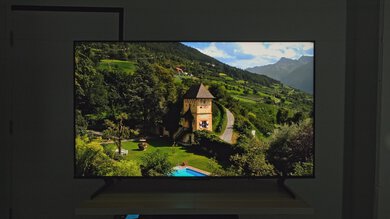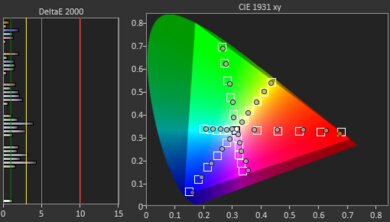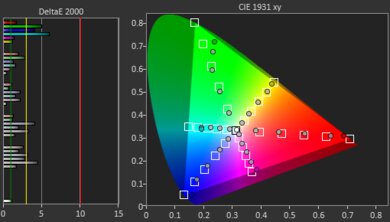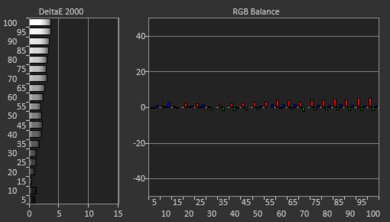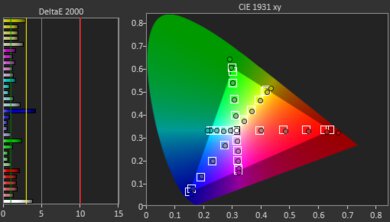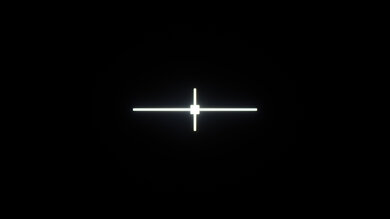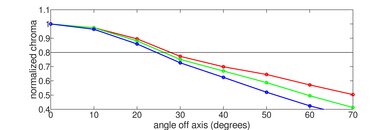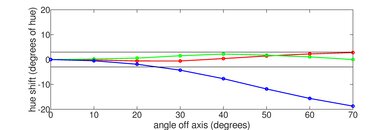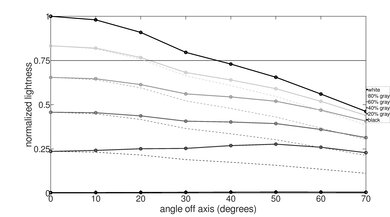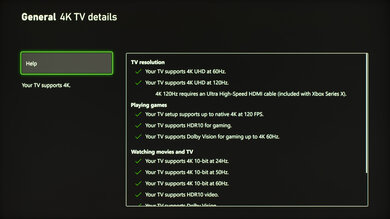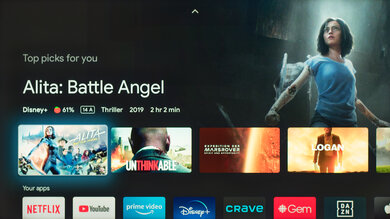The Hisense U8/U8H is a mid-range 4k TV released in 2022. It's the second-highest model in Hisense's 2022 ULED lineup, sitting above the Hisense U7H and below the Hisense U9H. It's available in three sizes, ranging from 55 to 75 inches, and all three sizes offer very similar performance. It replaces the Hisense U8G, and while it's very similar, Hisense has upped its specs a bit with a new Mini LED backlight with up to 528 dimming zones and a slightly updated design. It comes with the user-friendly Google TV 11 interface, an upgraded version of the Android TV interface found with the 2021 Hisense lineup. It has a great selection of gaming features, including HDMI 2.1 bandwidth on two of its HDMI ports and FreeSync variable refresh rate (VRR) support.
Our Verdict
The Hisense U8H is an excellent TV all-around. It's an excellent TV for watching movies in a dark room thanks to its high contrast ratio and great local dimming feature. HDR content looks incredible as it gets incredibly bright and has a wide color gamut, so the latest movies look incredibly realistic and lifelike. It's a great TV for watching shows or sports in a bright room, but because it has a narrow viewing angle, it's not a good choice for a wide seating arrangement as the image degrades when viewed off-center. Finally, it's an amazing TV for gaming thanks to its HDMI 2.1 bandwidth, VRR support, low input lag, and fast response times.
- Fantastic contrast and black uniformity results in deep blacks in a dark room.
- Exceptionally bright in both SDR and HDR.
- Excellent reflection handling.
- Image degrades when viewed from the side.
The Hisense U8H is a great TV for watching shows during the day. It has exceptional peak brightness and excellent reflection handling, so glare isn't an issue even in a very bright room. It has a great smart interface with a huge selection of streaming apps, so you're sure to find your favorite shows. It also upscales lower-resolution content well, which is great if you have TV shows on Blu-ray or DVD. Sadly, it has a narrow viewing angle, so it's not ideal if you have a wide seating arrangement or if you like to move around with the TV on, as the image degrades as you move off-center.
- Exceptionally bright in both SDR and HDR.
- Excellent reflection handling.
- Low-resolution content is upscaled without any issues.
- Image degrades when viewed from the side.
- Poor low-quality content smoothing.
The Hisense U8H is a great TV for watching sports in a bright room. It has excellent reflection handling and exceptional peak brightness, so it can easily overcome glare in any viewing environment. It has great gray uniformity, with just a bit of dirty screen effect in the center, and it has a fast response time, so fast action is clear. On the other hand, it has a sub-par viewing angle, so it's not ideal for a wide seating arrangement, as the people watching it from the sides will see a faded, washed-out image.
- Exceptionally bright in both SDR and HDR.
- Excellent reflection handling.
- Low-resolution content is upscaled without any issues.
- Image degrades when viewed from the side.
The Hisense U8H delivers an amazing gaming experience. It has superb low input lag and an excellent response time, delivering a very responsive gaming experience, although, unfortunately, the TV's response time causes red ghosting in some content. It also has a great selection of gaming features, including FreeSync variable refresh rate support. It has HDMI 2.1 bandwidth on two ports, meaning it can take full advantage of the Xbox Series S|X and the PS5.
- Fantastic contrast and black uniformity results in deep blacks in a dark room.
- Exceptionally bright in both SDR and HDR.
- Superb low input lag.
- Excellent motion handling and a fast response time.
- Low-resolution content is upscaled without any issues.
- Great selection of gaming features.
- Red ghosting in some content.
The Hisense U8H is a great TV for watching movies in HDR. Thanks to its fantastic contrast ratio, impressive local dimming feature, and incredible peak brightness in HDR, bright highlights look incredible. It tracks the PQ EOTF extremely well, ensuring that most content looks the way the content creator intended. It also has an excellent color gamut, so most HDR content looks vivid and lifelike. Unfortunately, due to its fast response time, there's some noticeable stutter in slow panning shots.
- Fantastic contrast and black uniformity results in deep blacks in a dark room.
- Exceptionally bright in both SDR and HDR.
- Wide color gamut and amazing color volume.
- Noticeable stutter in low frame rate content.
- Poor low-quality content smoothing.
The Hisense U8H is an amazing TV for gaming in HDR. It delivers an amazing gaming experience thanks to its low input lag and excellent response time, although, unfortunately, the TV's response time causes red ghosting in some content. It has a great selection of gaming features, such as FreeSync VRR support and HDMI bandwidth on two ports. HDR content looks amazing thanks to its fantastic contrast ratio, impressive local dimming feature, and incredibly high peak brightness, so bright highlights look superb, delivering a more realistic picture in some games.
- Fantastic contrast and black uniformity results in deep blacks in a dark room.
- Exceptionally bright in both SDR and HDR.
- Superb low input lag.
- Excellent motion handling and a fast response time.
- Wide color gamut and amazing color volume.
- Great selection of gaming features.
- Red ghosting in some content.
The Hisense U8H is a good TV for use as a PC monitor, but there are a few issues with it. It has very good uniformity, so there's very little dirty screen effect in areas of uniform color, like a website with a uniform background. It has low input lag and a fast response time, ensuring a smooth, responsive desktop experience. It also has a narrow viewing angle, so the sides of the screen appear washed out if you're sitting too close to the screen.
- Exceptionally bright in both SDR and HDR.
- Superb low input lag.
- Excellent motion handling and a fast response time.
- Image degrades when viewed from the side.
Changelog
- Updated Jun 11, 2024: Unfortunately, this TV died as part of an in-depth investigation into edge-lit TVs. It has been removed from the Accelerated Longevity Test.
- Updated May 27, 2024: Mentioned the newly-reviewed Hisense U8/U8N in the HDR Brightness section of this review.
- Updated May 02, 2024: We uploaded the latest brightness measurements and uniformity photos for the Accelerated Longevity Test.
- Updated Feb 13, 2024: We uploaded the latest brightness measurements and uniformity photos for the Accelerated Longevity Test.
Check Price
Differences Between Sizes And Variants
We tested the 65-inch Hisense U8H, and the results are also valid for the 55-inch and 75-inch models. In Canada, it's known as the Hisense U88H, and it performs the same. There are similarly named international models, including the U8HG, U8HSG, and the U8H in Australia, but these models use a completely different panel and smart platform, and these results aren't valid for those models.
| Size | US Model | Local Dimming Zones | Panel Type |
|---|---|---|---|
| 55" | Hisense 55U8H | 336 | VA |
| 65" | Hisense 65U8H | 504 | VA |
| 75" | Hisense 75U8H | 528 | VA |
The unit we tested was manufactured in May 2022, and you can see the label here.
Popular TV Comparisons
The Hisense U8H delivers incredible performance for the price, significantly outperforming any other TV in its price range, like the TCL 6 Series/R655 2022 QLED, making it by far the best mid-range TV on the market in 2022. It even competes well with more recent releases like the TCL QM8/QM850G QLED and even its own successor, the Hisense U8/U8K. It has limited processing capabilities compared to more expensive competitors, such as the Sony X90K/X90CK, resulting in worse gradient handling and slightly higher input lag. Sadly, it still has some bugs and issues, including red ghosting in some scenes.
See our recommendations for the best 65-inch TVs, the best 4k TVs, and the best TVs for bright rooms.
The newer Hisense U8N is an improvement over the Hisense U8H. The newer Hisense has noticeably improved contrast, giving it deeper blacks, which is especially noticeable when watched in darker rooms. The U8N is also brighter than the U8H, but this won't be noticeable in most content. If you care about image accuracy, the U8H is notably more accurate than its successor in HDR and SDR. Still, the U8N's image processing is vastly superior to the older model. The U8N is also a bit better for PC gamers due to its 4k @ 144Hz support, while the U8H is capped at 4k @ 120Hz.
The Hisense U8H is a bit better than its predecessor, the Hisense U8G. The U8H has a more effective local dimming feature, significantly increasing contrast with local dimming enabled. The U8H is also a lot brighter, and it displays HDR content much closer to the content creator's intent. Finally, the U8H has been updated to the latest Google TV interface, which is a bit faster and smoother than the older Android TV interface on the Hisense U8H.
The Hisense U8H is significantly better than the LG QNED85. The U8H has much better contrast, with significantly less blooming around bright areas of dark scenes. The Hisense also gets significantly brighter in both SDR and HDR, and it has a better anti-reflective coating, so it can better overcome glare and bring out highlights in HDR better. The LG has a much wider viewing angle, but unless you're in a moderately lit room with a wide seating arrangement, the Hisense is still much better.
The Hisense U8H is significantly better than the Hisense U7H. The U8H delivers much better picture quality, as it has a better local dimming feature with a Mini LED backlight. The U8H also delivers a better gaming experience, as it has a significantly faster panel with much less ghosting behind fast-moving objects. Finally, the U8H looks better in a bright room as it has much better reflection handling and gets much brighter in SDR, meaning it can handle more glare.

We buy and test dozens of TVs yearly, taking an objective, data-driven approach to deliver results you can trust. Our testing process is complex, with hundreds of individual tests that take over a week to complete. Most of our tests are done with specially designed test patterns that mimic real content, but we also use the same sources you have at home to ensure our results match the real-world experience. We use two main tools for our testing: a Colorimetry Research CR-100 colorimeter and a CR-250 spectroradiometer.
Test Results

Update 06/11/2024: Unfortunately, during our investigation of the uniformity issues this TV developed, the panel broke and can't be fixed. It has been permanently removed from this test.
The feet are wide-set and support the TV well. They're very thin, made of premium materials, with just a bit of wobble front to back. The feet can be adjusted in two distinct positions: a wide position and a narrow one.
Footprint of the 65-inch stand in the wide position: 44" x 14.76". In the narrow position, the 65-inch stand has a footprint of 31.3" x 14.76". In either position, the feet lift the TV about 3.4" above the table, so most soundbars fit in front without blocking the screen.
The back of the TV is made of plastic, with a textured horizontal pattern and vents along the top. There's also a built-in subwoofer on the back of the TV near the center. There are clips built-in to the feet to help with cable management. The inputs are on the left-hand side of the TV when facing the front, and they're easy to access even when the TV is wall-mounted.
The TV has fantastic contrast. Blacks are deep in a dark room, and the local dimming feature is extremely effective at boosting bright highlights while maintaining low black levels in bright scenes. It's a noticeable improvement over the Hisense U8G, especially with local dimming enabled, which is nearly twice as effective at boosting contrast.
Overall, the TV's processing keeps up very well with fast-moving objects, and lighting zone transitions aren't very noticeable, with minimal haloing.
The Hisense U8H is incredibly bright in HDR. Bright highlights stand out incredibly well, delivering an impactful HDR experience with both games and movies.
These measurements are after calibrating the HDR white point with the following settings:
- HDR Picture Mode: HDR Theater
- Backlight: Max
- Local Dimming: High
- Color Temperature: Warm1
Check out the 2024 Hisense U8/U8N for even better HDR brightness.
The TV's HDR brightness in Game Mode is fantastic. There's no noticeable difference in peak brightness from 'HDR Theater' mode. These measurements are after calibrating the HDR white point with the following settings:
- HDR Picture Mode: HDR Game
- Backlight: Max
- Contrast: 90
- Local Dimming: High
- Color Temperature: Warm1
The TV tracks the target PQ EOTF extremely well in the 'HDR Theater' Picture Mode with local dimming set to 'High'. There's a slow roll-off as the brightness approaches the TV's peak brightness, so fine details in bright scenes are preserved well. The EOTF in 'FILMMAKER' mode looks nearly the same as the 'HDR Theater' Picture Mode, but that mode locks you out of most settings. Setting Local Dimming to 'Low' results in a less accurate EOTF overall. When FreeSync is active, the TV hard clips when it reaches its peak brightness, as you can see here, leading to a loss of bright detail.
The HDMI Input Optimization setting has an impact on the PQ EOTF tracking. With it set to 'Text Clarity Optimization', there's more noticeable clipping in bright areas of the scene when gaming at 4k @ 120Hz, so the image looks a bit more washed out. The 'Picture Quality Optimization' setting more accurately tracks the PQ EOTF, and HDR games look much better. For the best results, you should only use the 'Text Clarity Optimization' setting when displaying text from a PC, not when gaming or watching media.
| Text Clarity Mode | PQ EOTF | In-Game Photo 1 | In-Game Photo 2 |
| Text Clarity | PQ-EOTF | 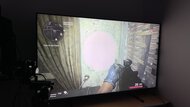 |
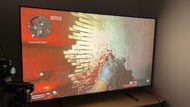 |
| Picture Clarity | PQ-EOTF |  |
 |
The brightness and EOTF tracking behave a bit differently depending on the FreeSync setting:
| FreeSync Setting | PQ EOTF | In-Game Photo 1 | In-Game Photo 2 |
| On | PQ EOTF | 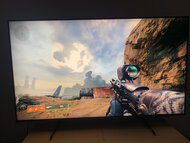 |
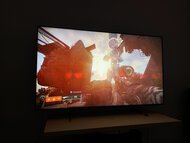 |
| Off | N/A | 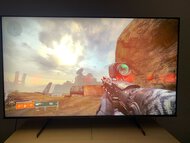 |
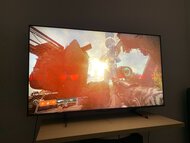 |
The Hisense U8H gets exceptionally bright in SDR. It's bright enough to overcome glare in any viewing environment, even outdoors in indirect sunlight. It can't get quite as bright with extremely bright scenes that cover close to the entire screen, but it's still bright enough to overcome glare.
These measurements are after calibration with the following settings:
- Picture Mode: Theater Night
- Backlight: Max
- Local Dimming: High
- Color Temperature: Warm1
The TV has an excellent HDR color gamut. It can display almost all the DCI-P3 color space used by most Ultra HD Blu-ray movies. It also has very good coverage of the wider Rec. 2020 color space, which is gaining in popularity, especially in animated films and some nature documentaries.
The Hisense U8H has amazing color volume in HDR. Thanks to its high peak brightness and fantastic contrast ratio, it can display colors well across all luminance levels. Colors are bright and vibrant, and it displays dark, saturated colors well.
The TV has excellent accuracy out of the box. Gamma follows the 2.2 target for a moderately lit room nearly perfectly, and the white balance is great. Color accuracy is excellent, and except for pure blues and whites, there are no noticeable issues. The color temperature is also excellent, neither too warm nor too cold.
The Hisense U8H has incredible accuracy after calibration to the 6500K white point. It's a bit tricky to calibrate, as minor changes to one point would make another look worse, but because it already has fantastic pre-calibration accuracy, you don't need to calibrate it too much for an accurate image.
You can see our full calibration settings here.
The TV has great gray uniformity. There's a bit of vignetting in the corners but very little dirt screen effect in the center. Dark scenes look even better, with the only noticeable issues being slightly brighter corners when compared to the TV's center.
The Hisense U8H has excellent black uniformity. With local dimming disabled, there's some noticeable backlight bleed, especially in the corners, and there are a few bright patches throughout the screen. With local dimming enabled, however, the uniformity is much better. There's a bit of blooming around bright elements of the scene, but it's very minor, thanks to the high native contrast ratio and full-array local dimming feature.
Sadly, the Hisense U8H has a sub-par viewing angle. The image fades and looks washed out as you move even slightly off-center. It makes it a poor choice for a wide seating arrangement, as anyone sitting off-center will see a degraded image. Unlike high-end TVs from other manufacturers, like the Sony X95J or the Samsung QN90B QLED, there's no wide-angle filter to improve the viewing angle.
The TV has excellent reflection handling. The semi-gloss coating significantly reduces the intensity of direct reflections and does a fantastic job with reflections from ambient lighting. Unlike many high-end TVs, there's no rainbow smear with bright lights.
The TV has alright HDR gradient handling. There's very noticeable banding in dark grays and visible banding in the entire range of greens, as well as in dark reds and bright blues. Other color gradients look great.
Like most TVs on the market, the Hisense U8H TV uses a BGR (Blue-Green-Red) subpixel layout instead of the traditional Red-Green-Blue layout. For video content, it doesn't cause any issues, but if you're planning on using this TV as a PC monitor, this reduces text clarity a bit, although there are easy workarounds for it. You can read more about this here.
The TV has an excellent response time. There's some blur around fast-moving objects, but it's mainly due to persistence blur. Games look great, and it's easy to make out fine details in fast action when watching sports. Unfortunately, like the Hisense U8G, there's noticeable red ghosting in some content.
The TV has an optional backlight strobing feature, commonly known as black frame insertion, to reduce persistence blur and improve the appearance of motion. It can flicker at both 60Hz with 60fps content or at 120Hz with 120fps content, ensuring that you don't see any duplications in motion.
Due to the TV's relatively fast response time, there's noticeable stutter when watching 24p content, like movies, as each frame is held longer on screen. It's especially noticeable in slow panning shots.
The TV automatically removes judder from any source, ensuring a smooth movie-watching experience.
The TV supports variable refresh rate (VRR), and it's compatible with all sources that support it.
The Hisense U8H has superbly low input lag, resulting in a responsive gaming or desktop experience. It's a bit higher than the best TVs on the market, like the LG C2 OLED, but it's not a significant difference.
Most common resolutions are supported, and it displays chroma 4:4:4 properly, which is essential for clear text from a PC. 4k @ 120Hz is also displayed properly, even with chroma 4:4:4, as long as you set the HDMI Input Optimization setting to 'Text Clarity Optimization'.
The Hisense U8H can take full advantage of the Xbox Series S|X. It's compatible with all supported features of the Xbox, including variable refresh rate support and 1440p support. The manufacturer advertises it to support 4k @ 120Hz Dolby Vision gaming, but it's limited to 4k @ 60Hz on the Xbox. If you start playing a game that supports Dolby Vision and have the refresh rate set to 120Hz, it'll fall back to HDR10 instead.
Two of the HDMI inputs support HDMI 2.1 bandwidth, with a maximum bandwidth of 48Gbps. Unfortunately, one of them is also the eARC port, so if you're planning on using an eARC device, you can only connect one other HDMI 2.1 device on the TV.
The U8H has an ATSC 3.0 tuner, allowing you to stream 4k channels over the air with an antenna. There are some reported issues with audio sync, and it appears to be downmixing Dolby 5.1 signals to PCM 2.0.
Unfortunately, there's no direct connection for composite sources. Instead, it requires an external breakout adapter, which is no longer included in the box.
The TV supports eARC and can pass advanced DTS and Dolby formats from a connected source to your soundbar or sound system without reducing audio quality.
The Hisense 65U8H has an okay frequency response. Thanks to its built-in subwoofer, it produces more noticeable low bass than the Hisense U8G, but it's still not as good as an external subwoofer with a receiver system or soundbar. It's a bit boomy in the high-bass, and high treble sounds are a bit under-emphasized, but otherwise, it has a well-balanced sound profile and gets decently loud.
This TV has good distortion performance. There's some audible total harmonic distortion, but mainly at high volume levels; it's not noticeable at moderate volume.
The TV comes with Google TV 11, an updated version of the Android TV platform used by 2021 Hisense TV models. It's redesigned with a few extra accessibility features, but other than that, it's the same user-friendly platform.
The Hisense U8H comes with a slightly redesigned remote compared to the remote that came with 2021 Hisense TVs. Like most modern remotes, it lacks a Numpad, and there are quick-access buttons to popular streaming services. The mic built into the remote and on the TV gives you access to Google Assistant and Alexa, so you can ask it to search for content, open apps, and switch inputs.













